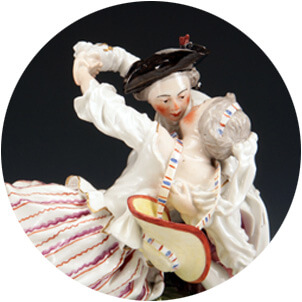
History
The Grand Ducal Hessian Porcelain Collection was set up by Grand Duke Ernst Ludwig of Hesse and by Rhine and was opened to the public in 1908. The collection is not the result of an individual collector’s passion but rather the product of a family’s inventory, gathered over centuries. Bordering the Herrngarten, the Prince Georgs Palace, a nice little garden palace, forms, together with its charming garden, a unique baroque ensemble.

Collection
Until today, in spite of several new acquisitions, the Grand Ducal Hessian Porcelain Collection still has the character of a family collection. Each cup, each plate and also each porcelain figure relates to its original owner. Almost all important European manufacturers of court porcelain in the 18th and 19th centuries, are represented in the collection, either in the form of commonly used tableware or as figures for table decoration, such as the court purchased, used and also received as gifts.
The main focus of the collection are the faience and porcelain of the Kelsterbach manufactory, which was supported by the Landgraves of Hesse-Darmstadt. Important manufacturers such as Höchst, Frankenthal, Meißen, Nymphenburg, Sèvres, Vienna and St. Petersburg are represented. A comprehensive selection of individual pieces and ensembles of nearly all known European manufactories are on display. With more than 4000 objects of faience, stone-ware and porcelain the collection provides an overview of the artistic development of European porcelain from its beginnings until the end of the 19th Century.
